This guide will tell you how to replace/install an ATV winch cable or synthetic winch rope, step-by-step.
The basic procedure for replacing an ATV winch line is about the same, whether you are:
The only real difference is how you attach the cable or rope to the winch drum (step 7), and what fairlead you should use.
Time consumption: 10-20 minutes from start to finish.
Mechanic skill level required: Low. If you know how to change a tire, you will be able to do this job.
Page Contents
Before you begin disassembly, make sure you have the proper tools and supplies at hand.
By now, you have probably decided whether you wish to install a new winch cable or a synthetic winch rope. If not, I recommend that you take a look at this post where we compare steel cables vs. synthetic ropes for ATV winching.
Some synthetic winch ropes come with an unfinished end where you have to splice the end loop yourself. However, most winch ropes on the market today come with an end loop straight out of the box. A metal thimble-insert makes the loop extra wear-resistant.
I recommend that you get a rope that comes with an end loop. It will save you time as well as reducing the risk of splicing the rope incorrectly. Therefore, this guide will not cover how to make an eye splice.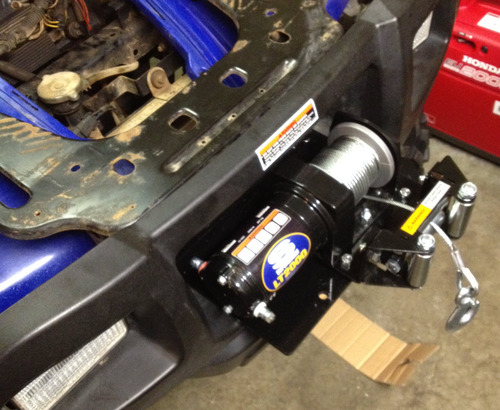
The type of fairlead you should use depend on whether you choose a steel rope or a synthetic cable.
With a steel winch cable, you should always use a roller style fairlead or a cast steel hawse. The steel cable will wear down a softer aluminum hawse fairlead in no time.
With a synthetic winch rope, you may use either steel roller fairleads or an aluminum hawse. A cast-iron hawse does not have a smooth enough surface and will prematurely wear the rope. An aluminum hawse, however, is much smoother, which makes it ideal for synthetic ropes.
Steel roller fairleads work fine a well, as long as the rollers are not damaged or too corroded. The rollers must overlap in the corners where they meet or you may get binding issues that will damage the rope. Most newer steel roller fairleads have overlapping rollers, while non-overlapping rollers is more common on older models.

Now that you got all the gear and tools you will need, you are ready to begin replacing the cable.
Remove the locking pin (usually a split-pin) and the bolt that connects the hook with the eye loop. This allows you to remove the fairlead. If the hook is in good shape, you will be reusing it with the new rope or cable.
Whether your existing fairlead needs replacing or not, you will most likely have to remove it to access the winch drum. It is held in place with two bolts, one on each side. Loosen the bolts and put the fairlead to the side for now.
On the side of your winch, you will find a switch that disconnect the winch motor from the cable drum. This is the free spool position, which enables you to unspool the winch cable by hand.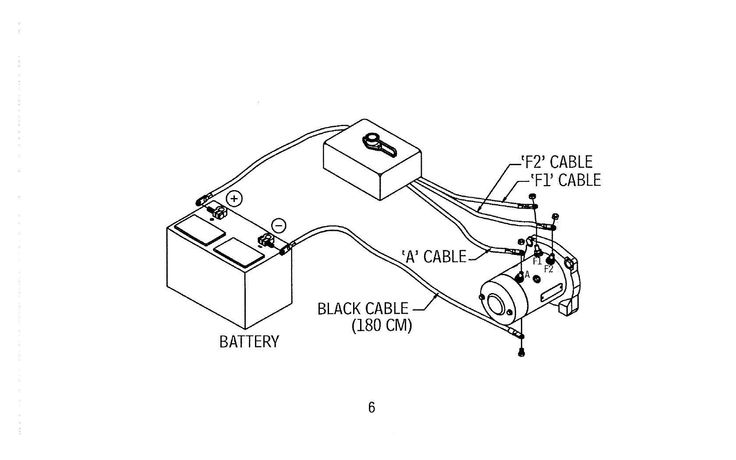
The design of this switch varies from manufacturer to manufacturer. On ATVs, a rotary-style knob at the very end of the winch is the most common.
On Warn winches, you should turn the knob clockwise until you hear a click, or until you can’t turn it any further without applying force. If you twist the knob too far, you need to disassemble the knob to get it working again.
With the knob in the free spool position, the drum should spin freely. In cold weather, however, the grease inside the winch gears may create some drag. But you should still be able to turn the drum by hand; it will just require a bit more pulling-force.
Make sure you use a pair of gloves for this step, especially if you are removing an old steel cable. The small metal burrs of a frayed cable are not going to be gentle with bare hands.
Grab the old line and pull on it so that it unspools. Pulling it by hand is better than using the winch motor to unspool the line. If it’s bound-up somehow, unspooling with the motor may only make it worse. So if you are able, unspooling by hand will work the best.
If it’s bound-up somehow, unspooling with the motor may only make it worse. So if you are able, unspooling by hand will work the best.
The end of the line is likely mounted to the drum. There is a number of ways to how this is done. Here are the most common methods for mounting a steel cable to the winch drum:
The cable goes through a hole in the core of the winch drum. An Allen set-screw is retaining the cable in the hole. Loosen and altogether remove the set-screw to release the cable. Take note of with hole the cable is threaded into the spool through. You must thread your new rope or cable the same way.
The cable goes through a hole in the winch drum core. At one end of the hole, there is a wedge-shaped slot that fits a loop of cable as well as a metal locking bead. The bead helps tighten the loop when you pull on the cable.
The bead helps tighten the loop when you pull on the cable.
To remove it, push the cable from the opposite side of the loop. This will release the bead so that the cable can be pulled out of the drum.
Older ATV winches often attached the cable by using a screw to the sidewall of the winch drum. This method is not that common nowadays, but you may run into it if you are replacing the cable of an older ATV.
If you’re replacing a worn synthetic rope, any of the methods above may have been used to hold the rope in place.
In adition, there is the method I will be recommending in this post, where you feed the rope through the hole in the winch drum core and make a knot around itself.
Its a good idea to take a photo of the knot before untying it. The hardest part of installing a new rope is to make a proper knot.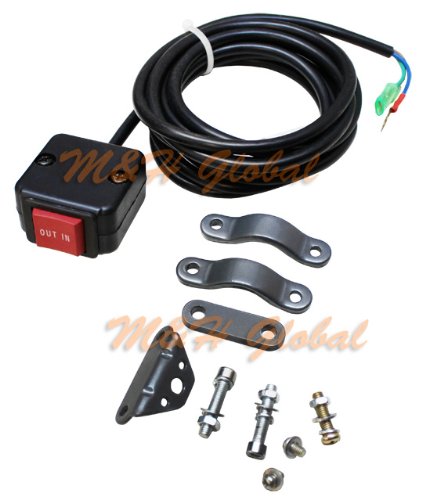
In step 7, I will show you how to create a knot like this.
Steel cables have been known to damage the winch drum or the fairlead rollers. Now is a good time to inspect them both.
Any sharp eges has to be adressed before you install your new rope, or your rope will get damaged. Use a file or a piece of sandpaper to file down any burrs or grooves to a smooth surface.
This step depends on what style of winch drum you have, and whether you are installing a steel cable or synthetic rope.
If your winch drum has a hole and an Allen set-screw, thread the end of the cable into the hole the same direction as your old cable was sitting. Lock it in place by tightening the Allen screw snug.
Lock it in place by tightening the Allen screw snug.
If the drum has the loop-and-metal-bead style locking mechanism, the procedure is not that different.
Feed the cable through the hole of the drum in the same direction as the old cable. Let a few inches of cable go through the spool. It should be enough to create a loop. Bend the cable into a U-shape, and let is slide back into the slot on the winch drum.
Insert the metal bead inside of the loop before you tighten the cable by pulling on the long end. Tighten as hard as you can so the cable sits firmly.
With synthetic ropes, it’s not that you can’t use the set screw or metal wedge method to mount the rope, but there are better ways that will make an even more slip-proof installation.
The method I find work best, and what many manufacturers recommend, is making a knot that tightens as you put tension on the rope. Here is how to do it:
The winch drum mounting-hole is a bit off-center.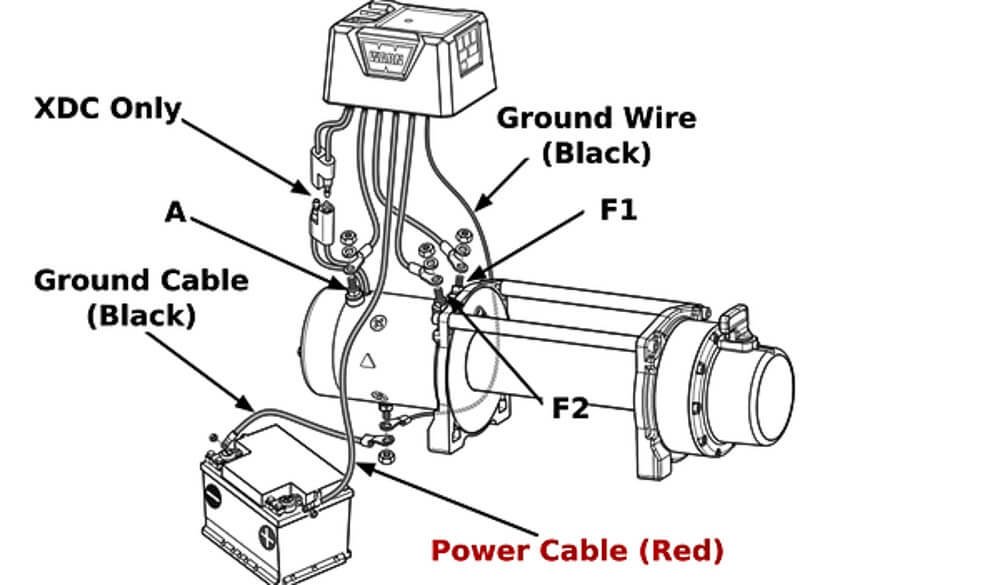 You need to make sure the drum is positioned correctly so that the rope will begin wrapping around the thickest part of the drum when you spool in. Which position is correct depends on which way the drum turns when you spool in.
You need to make sure the drum is positioned correctly so that the rope will begin wrapping around the thickest part of the drum when you spool in. Which position is correct depends on which way the drum turns when you spool in.
Feed the free end of the rope through the hole, with a few inches of rope sticking out the other side of the drum.
Rotate the spool 180 degrees upwards so that the short end of rope points towards you. If the hole is positioned at the bottom, see step 1 above, you need torotate the spool 180 degrees downwards instead.
Grab both the short and long end of the rope.
While holding both ropes, rotate the spool back down 180 degrees.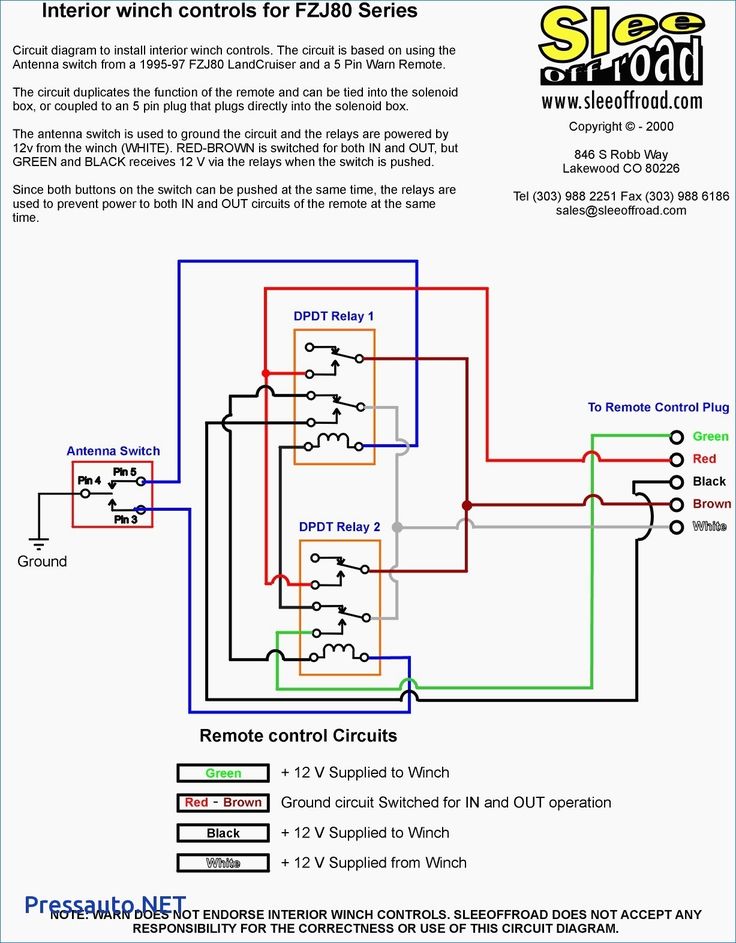 Again, if the hole through the drum was positioned near the bottom after finishing step 1, you will now need to rotate the drum up instead. The end result should look the same regardless of which direction your winch turns; the knot will just be upside down.
Again, if the hole through the drum was positioned near the bottom after finishing step 1, you will now need to rotate the drum up instead. The end result should look the same regardless of which direction your winch turns; the knot will just be upside down.
The shorter length of rope is now creating a loop of rope around the spool. Allow a little slack, thread the shorter end of rope from the outside and in underneath itself to make a knot.
Tuck the shorter length of rope under it’s own loop to create the knot.
The shorter length of rope should now lay across the spool.
Tighten the knot by holding the shorter length of rope with one hand while pulling on the longer length of rope with the other.
Slide the knot all the way outwards on the spool. You are now ready to begin reeling the rope back onto the spool.
Turn off the free spool knob by rotating it in the opposite direction from what you did earlier. This will engage the winch motor so that you can spool the new rope or cable on to the winch drum.
From this point on, make sure you keep your hands at safe distancefrom the winch as you will be using the winch motor to spool the new rope or cable on to the drum.
The winch-line must be kept under constant tension as you spool it on to the drum. Otherwise, it may get jammed between lower layers of rope when you use the winch later on.
You will also need to guide the rope so that it spools neatly. Guide the rope at a steady pace from one side to the other. You should get a flat and even layer of rope across the full width of the drum.
If you have a remote, it is possible to do this step alone. But it’s easier to get the rope to wrap neatly if you get help from a friend.
One person should operate the winch controls while the other guide and keep the rope under tension.
Lay out the winch line before you start spooling. This will reduce the risk of tangling the rope.
Start spooling from the knot-side and work your way to the other side of the drum.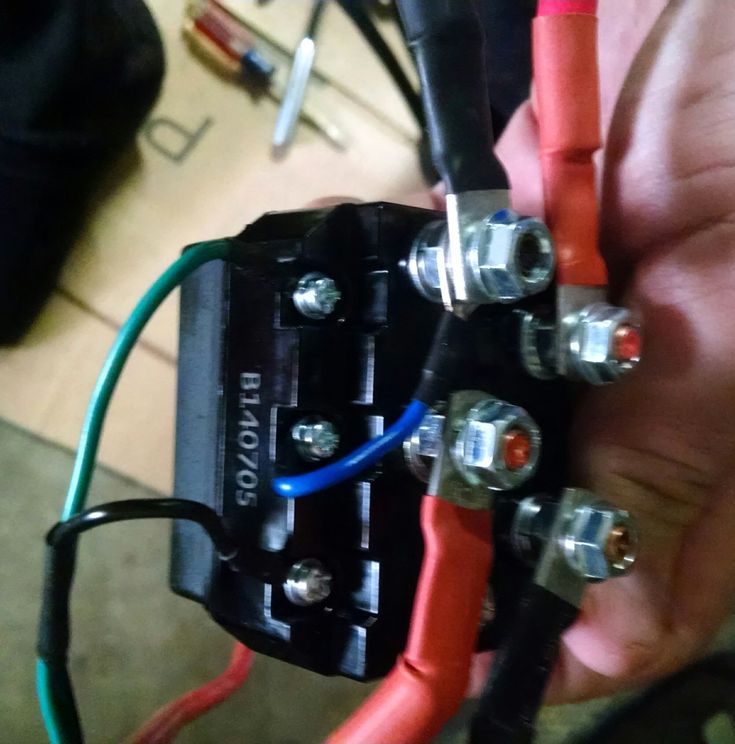 Each rope winding should be touching the previous one.
Each rope winding should be touching the previous one.
This is how it should look like after half a turn.
This is how it should look like after one whole turn.
Then after two turns.
Continue winding until you get a flat layer of rope across the whole width of the winch drum.
When you reach the edge, it’s time to turn back and lay a new layer of rope across the drum. Make sure you maintain a steady pull on the winch line and continue untill all of the rope or cable has been spooled on to the drum.
Use the same method to spool a steel cable if that is what you are installing. Make sure to use gloves.
Start at one end of the drum.
And work your way across the width of the drum in a flat, smooth pattern.
In this photo, I’m using this method for installing a synthetic winch rope on my father’s new Textron. The steel cable had to go.
Thread the cable through the fairlead and mount the fairlead using the proper hardware.
Make sure the winch line won’t be scraping against the fairlead mounting plate. There should be at least 1/4″ clearance between the fairlead openings and the edges of the mounting plate.
If you are replacing your steel roller fairlead with an aluminum hawse, you may or may not not be able to use the same mounting hardware.
Therefore it is always a good idea to have a look at your mounts before buying the new hawse to make sure it will fit. It’s much easier to choose a different model with a slightly different design than to struggle with bolts that don’t fit.
To protect your fairlead from beeing damaged, it’s recommended to install a rubber bump stop. They are especially important if you are replacing your steel rollers with a softer material aluminum hawse.
If you don’t have one right now, just skip this step for now, but make sure you add one later.
Rubber cable stoppers are a cheap way of protecting both your winch and winch hook.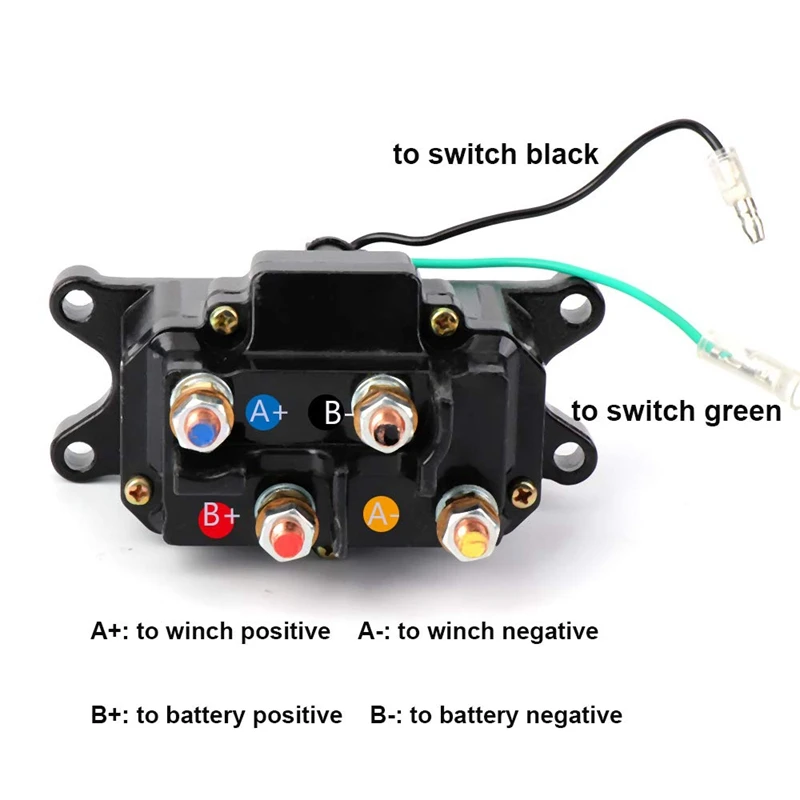
Install the winch hook, and you are done. Make sure you bend the split pin so the bolt won’t fall out.
You are now done replacing the winch cable or rope of your ATV.
When you perform this job, it’s recommended that you perform a couple of quick and easy maintenance steps while you are at it. These will help prevent some of the common issues you may run into while operating your winch later on.
Corroded or loose terminals on your winch are a common cause of a winch that will not work. It’s also a common cause of a battery that keeps draining. In this post, I take a look at other possible reasons for a battery that keeps going dead.
Disconnect both terminals and remove any dirt or corrosion using a copper wire brush or some fine sandpaper. Repair or replace any damaged wire or connectors before you reconnect the connectors to the terminals.
It is not uncommon that a winch bolt or two may break or come loose. Now is the perfect time to make sure all bolts are in place and in good shape. Replace any missing or broken bolts with correct spec new ones.
If your steel winch cable keeps getting flat spots and breaking even under very little stress, it’s a good idea to replace it with a synthetic winch rope. Also, replace the roller fairlead with a hawse fairlead to go with the synthetic rope. This setup will last a lot longer.
The cable should be rated at least double the pulling capacity of your winch. Do not get a rope or cable that is too thick as it will reduce how much you are able to fit on the spool. Typical synthetic rope size is 3/16 inch (5mm), while steel wires generally are slightly smaller with a size of 5/32 inch (4mm).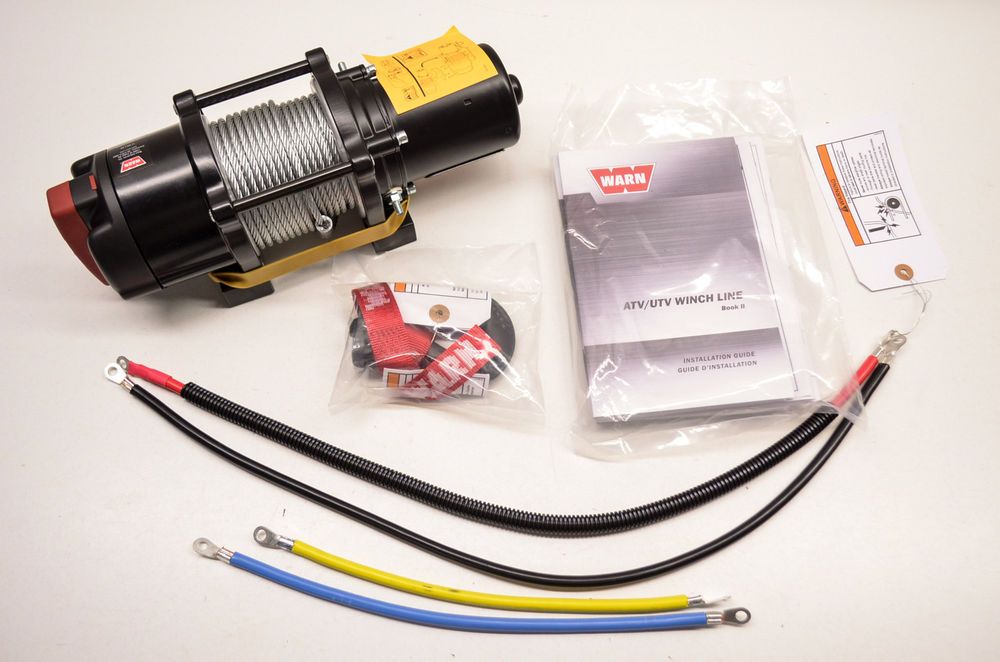 Typical ATV winch cable length is 50 ft. (15m).
Typical ATV winch cable length is 50 ft. (15m).
We may earn a commission for purchases using our links. Learn more
Several off-road enthusiasts have been unfortunate to have a winch cable break when they needed it most. While getting the best winch and cable on the market provides reliability, there’s never a guarantee the cable won’t break. Even a cable that can easily withstand the weight of your car can still snap or break. And this isn’t because the cable is weak or of low quality, but because other factors are in play.
You see, every time you use a winch, the cable winds on the drum. If you aren’t keen enough to do it right, the cable gets twisted, which over time causes it to lose its quality. Also, exposure to elements causes the strongest cable to lose its toughness and quality over time. Synthetic ropes take the most damage from UV rays.
Even if you take measures to protect the winch cable from the elements, the heat generated from friction when winching your vehicle causes subtle damage. Eventually, the cable snaps. If your cable snaps when winching, or if it’s too damaged to sustain the weight of your vehicle, you should replace it.
Eventually, the cable snaps. If your cable snaps when winching, or if it’s too damaged to sustain the weight of your vehicle, you should replace it.
The process is easy but might be a little confusing to newbies. We’ll explain the cable winch replacement process and share some safety tips when replacing the winch cable. Bear in mind that the process might differ slightly depending on your winch. As such, you should always read through the manufacturer’s manual for the finer details.
But before you remove the old cable from your winch, notice how it’s fixed to the winch drum. The main portion of the winch is designed with a threaded bore on the drum where you fix the synthetic winch line or cable with a bolt. And while some winches have different attachment types, the threaded bore is the most common.
Once you remove the old cable using the roller guide from the winch, inspect the drum for any sharp objects that can damage your new winch rope after installation. This is most important when replacing steel cables since they cause the most damage to the winch drum.
This is most important when replacing steel cables since they cause the most damage to the winch drum.
Often, steel cables kink, fray, and burr with regular use. In the end, they develop tiny sharp edges on their length, which in turn scratch the surface of the drum, making it rough. If you come across these bumps, you should sand them to create a smooth drum surface. This process may be a little tasking but will help preserve the new winch cable.
Before you spool your rope, you’ll need to install a new fairlead.
A fairlead is a guide that enables the cable to spool on the drum without getting frayed or damaged during use. Fairleads are located in front of the electric winch, and without them, the new winch’s lifespan is greatly reduced.
Aluminum fairleads are perfect for synthetic winch lines since they are designed with sleek coverings and don’t damage synthetic cables. Cast steel fairleads lack the smooth protective covering and are therefore not ideal for use with synthetic cables.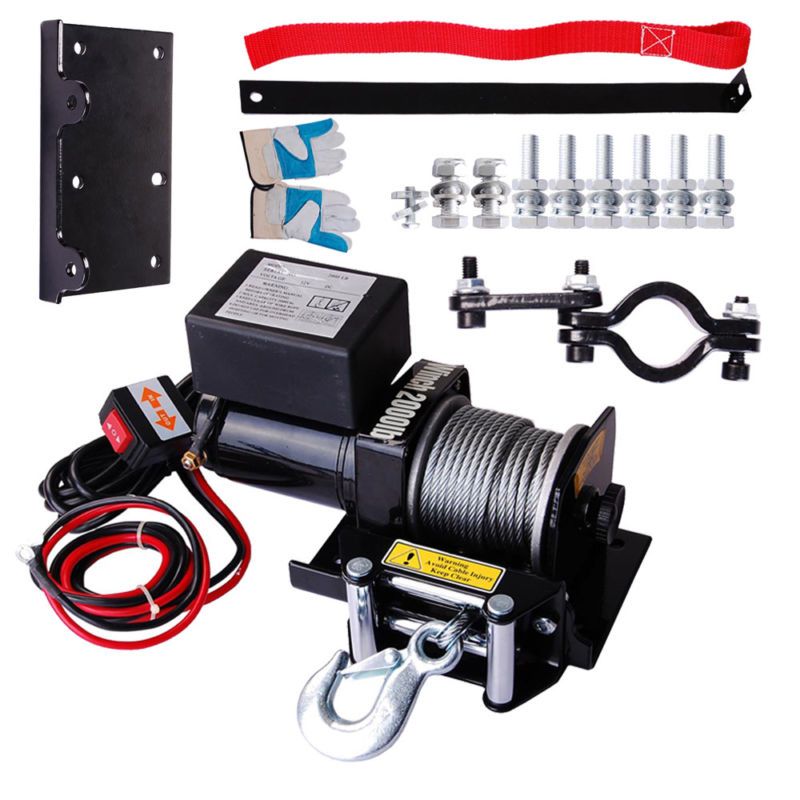
You can use a steel pulley fairlead but make sure the rollers aren’t hollow and are smooth. Aside from this, you should make sure the rollers overlie on each other. Without the overlay, the roller could create a clearance in the guide corner where the cable might get stuck during use. When this happens, the cable gets damaged.
Aside from picking the right roller fairlead based on the type of cable you choose for the drum make sure there’s sufficient space between the ends of the winch mounting plant and the fairleads. The space should be between 0.37 inches and 0.5 inches. If you don’t keep this space, the line may get cut by the sharp edge.
As pointed out earlier, you need to know how the old cable was attached to the winch drum. At this point, you’ll attach your new cable exactly how the old cable was. Usually, at the end of the cable are small diameter loops that you can use to attach to the drum.
Some drum kits come with bolt-ons that you can use with different drums. Pick one that is perfect for your drum and fix it to the cable. In a few cases, you’ll need to have a nylon washer that fits on the kit and gives extra grip to the mount on the drum.
Pick one that is perfect for your drum and fix it to the cable. In a few cases, you’ll need to have a nylon washer that fits on the kit and gives extra grip to the mount on the drum.
Before you wind the new cable on the drum, you should unwind it and stretch it out on the smooth ground. This will make the winding process easier. Ensure there are no entanglements on the cable before you start spooling.
Let’s take a step back to cable attachment. Learning how to attach the cable is important since it determines whether the winch line holds when winching. Here’s how you do it right.
Pass the end of the winch cable through the roller fairlead and then under the drum. From above, pass it through the attachment point. After this, attach the new cable to your drum.
Some winches have to overheat protection which closes the cable on the first reel. We recommend using the protective cover when you wind it on the drum to protect the cable from heat generated from friction and abrading.
Always keep your hand safe from the winch when you guide it to wrap neatly on the drum. We recommend having an assistant help you with this process since it’ll be difficult to guide the cable and work the winch controller simultaneously.
With a partner, you can lead the line, and they can control handle the winch controller. You should exercise extra caution by wearing protective gloves even as you keep your hands a safe distance from the winch drum.
As you spool the cable, ensure that you have complete layers of cables on the drum so that the cable is always attached to the drum. The friction generated from the turning helps to keep the rope on the drum. Also, a tightly spooled cable is better because it allows you to loop more cable on the drum.
Also, the line mustn’t overlap itself before the full width of the winch’s drum is covered. As you guide the cable from one end of the drum to the other, ensure it’s clean and even.
And with that, you are done and good to go.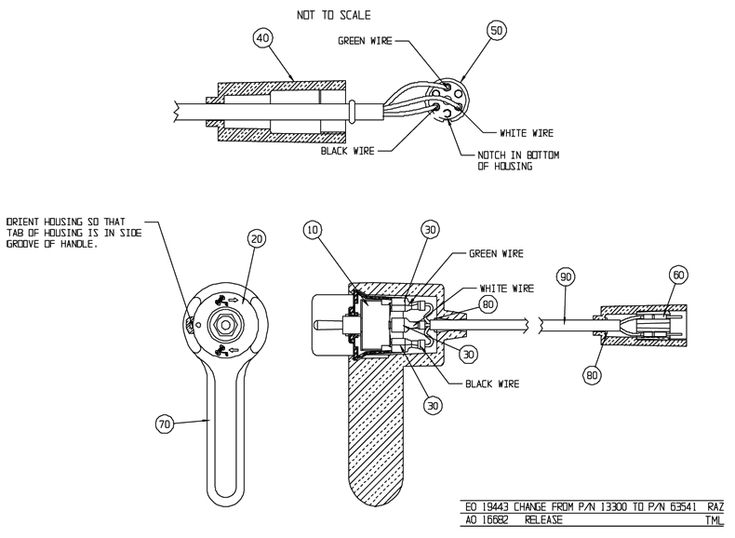
Note: every time you winch your car, get into the habit of unspooling the entire line and respool it correctly.
Needless to say, steel wire cables are tough. They have a high tensile strength that makes them resistant to snapping. They also dissipate heat well and are economical. Unfortunately, they come with serious cons.
For instance, a steel cable is rigid and doesn’t fit properly on an electric winch drum. Moreover, they are heavy, and burrs appear after several uses, which can hurt your hands. And though it is resistant to snapping, if it ever snaps, it becomes a danger to you and your car. This is because steel cables retain kinetic energy while under a heavy load.
The force from the kinetic energy is strong enough to cut through flesh. And if the steel cable is thin enough, it can slice through bones. To reduce the chance of getting hurt when it snaps, you should place a weight, like a sweater, along the length of the cable to dampen the snap force.
Because of the dangers steel cable poses, consider using synthetic winch rope as an alternative.
Ropes are elastic and don’t pose the same dangers cables pose because they don’t store kinetic energy. As such, it doesn’t snap back with the same intensity. Also, when you wind a winch rope on a drum, it takes up minimal space, which is its greatest advantage. Therefore, you get to install a longer cable. Along with this, it is light compared to steel cables.
Like the cables, ropes have some cons. The major one is delamination due to the ingress of sand and dirt in the inner strands. Luckily, you can avoid this problem by washing your winch rope with soapy water once in a while and drying it well.
Aside from this, rope tends to be more expensive than cable initially and in the long run. Why?
Well, rope needs a little more maintenance than cables, and they are also easily damaged by small debris and UV rays.
Yes, you can. As you plan to do so, consider several factors, including price and safety. Though rope is safer, it tends to be a little more expensive than steel cable rope.
As you plan to do so, consider several factors, including price and safety. Though rope is safer, it tends to be a little more expensive than steel cable rope.
Synthetic winch rope lasts for ten years. However, getting a year or two from the rope is a good deal with substantial, heavy use. The beauty of using synthetic ropes is that even if it fails, you can safely tie them together and get out of a sticky situation.
You should replace your winch cable when you notice slight splicing and fraying. You cannot judge winch cable replacement with time as you do with an ATV oil change. This is because several factors come into play. Provided the cable is in good shape, you can continue using it. However, slight damages are enough to be dangerous and warrant a replacement.
And there you have it, a simple and easy-to-follow process of replacing your steel cable or synthetic rope. It’s important to get it right because it affects how efficient and safe the device is.
It’s important to get it right because it affects how efficient and safe the device is.
Website | + posts
I’m Ruiru Kibet, an avid writer and techie that has taken a keen interest in offroading. As I explore nature and troubleshoot with different offroad products and techniques, I’ll share them with you. The goal is dumb it down and help you experience the best of nature.
A winch is a must have for off-road riding. It allows you to pull a stuck ATV out of mud, water or deep ruts. Many models of CFMOTO ATVs and ATVs have a winch from the factory, for others it needs to be purchased separately. In this article, we will tell you how the winch works, what to look for when choosing, and also give useful tips on how to use it.
ATV winch is a drum with a cable. An electric motor is located on one side of the drum, and a gearbox on the other. Rotation from the electric motor to the gearbox transmits a shaft that passes inside the drum. The gears of the planetary mechanism are located in the gearbox.
An electric motor is located on one side of the drum, and a gearbox on the other. Rotation from the electric motor to the gearbox transmits a shaft that passes inside the drum. The gears of the planetary mechanism are located in the gearbox.
Reducer reduces speed and increases traction. The rotation from the gearbox is transmitted to the drum, which winds the cable, creating traction and gradually pulling out the stuck equipment.
One of the key parameters to consider when choosing a winch is traction. It determines the maximum weight of the load that can be torn off the surface. With each skein of the drum, the winch force decreases.
Thrust is measured in pounds (labeled on winches as lbs), 1 lb = 0.45 kg. The force depends on a number of features: the diameter of the drum, the number of wound turns, the power of the electric motor, as well as the gear ratio of the gearbox.
It is not always necessary to choose the most powerful and fastest winch: the more powerful the mechanism, the more difficult it is to handle. Beginners can harm equipment and even their health - it is not uncommon for a broken cable or a broken hook to cause injury.
Beginners can harm equipment and even their health - it is not uncommon for a broken cable or a broken hook to cause injury.
Matches the cubic capacity of the ATV:
Steel - cheap and easy. Requires work with gloves, not repairable. May cause injury if mishandled.
Synthetic - requires maintenance but is easy to use. It does not "shoot", and if the cable is damaged or torn, it can be braided on the spot.
Most experts believe that material choice should be based on personal preference: some riders lean towards steel over time, others towards synthetics.
The winch is installed on a special platform on the ATV frame.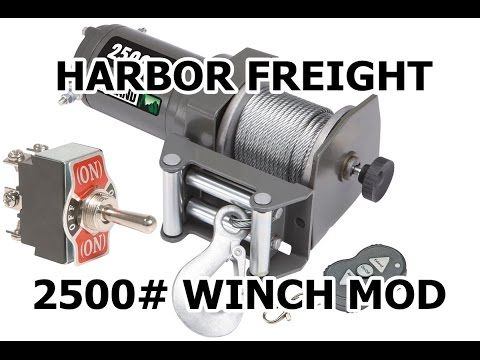 If there is no platform, you need to buy it and install it according to the instructions. The site has standard anchor points that fit classic winches up to 3,500 feet of pull.
If there is no platform, you need to buy it and install it according to the instructions. The site has standard anchor points that fit classic winches up to 3,500 feet of pull.
When choosing a winch, pay attention to the width of the drum:
With certain skills, you can modify the fasteners and install almost any winch - the main thing is not to make the fasteners “to break” and not to strengthen weak points. If the ATV is under warranty, it is advisable not to touch the frame and buy a standard winch.
Installing the winch is easy, but the connection will have to be tricky. To lay the wiring, it is advisable to remove the plastic from the ATV. The winch must be connected to the control unit and battery. It is recommended to keep the power cable as short as possible to avoid current loss. All wires must be hidden in the corrugation so that they do not come into contact with the frame and are protected from moisture.
It is recommended to keep the power cable as short as possible to avoid current loss. All wires must be hidden in the corrugation so that they do not come into contact with the frame and are protected from moisture.


If you have any questions or would like further advice on purchasing, installing, operating and maintaining an ATV or ATV winch, please contact your nearest authorized CFMOTO dealer.
Dealers CFMOTO
Posted by by MotoDoctor
Owners of any ATVs have probably encountered the problem of a broken electric winch cable. It would seem that a sufficiently powerful cable and, according to all its characteristics, must withstand the load expected for this model of an all-terrain vehicle. It turns out that the cable breaks not at all because it is weak.
The fact is that on electric winches of ATVs, when the cable is wound on the drum, the cable bites and breaks. After that, the cable loses its qualities. In the place where he was bitten, and a break occurs. All this is because the regular steel cable is very rigid and does not fit well on the electric winch drum. Yes, a few more minuses can be added to this, these are burrs about which you can injure your hands and in the event of a break, the steel cable is very unsafe. Therefore, it is better to replace such a cable without waiting for problems. The best alternative to steel cable is synthetic or Kevlar. Cables made of such material have good elasticity, and when winding they occupy a smaller volume on the drum, which makes it possible to install a longer cable than a metal one on the ATV electric winch. Of course, there is also a drawback to the synthetic and Kevlar cable. When dirt, sand gets inside the cable, it eventually becomes shaggy and delaminates. This is the only negative that can be easily eliminated by periodically washing the cable in soapy water and further drying. Replacing the cable on an ATV electric winch is not very difficult. But for this you need to remove the winch. Using the BRP Outlander 800R ATV as an example, we will consider replacing a steel cable with a synthetic one.
Yes, a few more minuses can be added to this, these are burrs about which you can injure your hands and in the event of a break, the steel cable is very unsafe. Therefore, it is better to replace such a cable without waiting for problems. The best alternative to steel cable is synthetic or Kevlar. Cables made of such material have good elasticity, and when winding they occupy a smaller volume on the drum, which makes it possible to install a longer cable than a metal one on the ATV electric winch. Of course, there is also a drawback to the synthetic and Kevlar cable. When dirt, sand gets inside the cable, it eventually becomes shaggy and delaminates. This is the only negative that can be easily eliminated by periodically washing the cable in soapy water and further drying. Replacing the cable on an ATV electric winch is not very difficult. But for this you need to remove the winch. Using the BRP Outlander 800R ATV as an example, we will consider replacing a steel cable with a synthetic one. The order of dismantling the electric winch:
The order of dismantling the electric winch:
When the electric winch is removed from the ATV, the old steel cable can be removed and the new synthetic cable wound on. Secure the beginning of the cable well on the drum so that it does not jump out of it when winding. We recommend that you paint the first meter of the beginning of the cable on the drum red, this will serve as a signal that the cable is ending and will give you the opportunity to leave a few turns on the drum, thereby eliminating the possibility of disconnecting the cable from the drum under heavy load. Installing the winch on the ATV is done in the reverse order. Now the new synthetic cable will be much more reliable and safer.